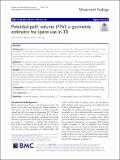Files in this item
Potential path volume (PPV) : a geometric estimator for space use in 3D
Item metadata
| dc.contributor.author | Demšar, Urška | |
| dc.contributor.author | Long, Jed A. | |
| dc.date.accessioned | 2019-05-01T09:30:06Z | |
| dc.date.available | 2019-05-01T09:30:06Z | |
| dc.date.issued | 2019-04-29 | |
| dc.identifier | 258462205 | |
| dc.identifier | b6e70349-0b8d-4c5c-b33d-ca8cc7365048 | |
| dc.identifier | 85065243476 | |
| dc.identifier | 000466378800001 | |
| dc.identifier.citation | Demšar , U & Long , J A 2019 , ' Potential path volume (PPV) : a geometric estimator for space use in 3D ' , Movement Ecology , vol. 7 , 14 . https://doi.org/10.1186/s40462-019-0158-4 | en |
| dc.identifier.issn | 2051-3933 | |
| dc.identifier.other | ORCID: /0000-0001-7791-2807/work/57088506 | |
| dc.identifier.uri | https://hdl.handle.net/10023/17621 | |
| dc.description | Urška Demšar is supported by a Leverhulme Trust Research Project Grant (RPG-2018-258). | en |
| dc.description.abstract | Background: Many animals move in three dimensions and many animal tracking studies collect the data on their movement in three physical dimensions. However, there is a lack of approaches that consider the vertical dimension when estimating animal space use, which is problematic, as this can lead to mistakes in quantification of spatial differentiation, level of interaction between individuals or species, and the use of resources at different vertical levels. Methods: This paper introduces a new geometric estimator for space use in 3D, the Potential Path Volume (PPV). The concept is based on time geography and generalises the accessibility measure, the Potential Path Area (PPA) into three dimensions. We derive the PPV mathematically and present an algorithm for their calculation. Results: We demonstrate the use of the PPV in a case study using an open data set of 3D bird tracking data. We also calculate the size of the PPV to see how this corresponds to trip type (specifically, we calculate PPV sizes for departure/return foraging trips from/to a colony) and evaluate the effect of the temporal sampling on the PPV size. PPV sizes increase with the increased temporal resolution, but we do not see the expected pattern than return PPV should be smaller than departure PPV. We further discuss the problem of different speeds in vertical and horizontal directions that are typical for animal movement and to address this rescale the PPV with the ratio of the two speeds. Conclusions: The PPV method represents a new tool for space use analysis in movement ecology where object movement occurs in three dimensions, and one which can be extended to numerous different application areas. | |
| dc.format.extent | 14 | |
| dc.format.extent | 6800302 | |
| dc.language.iso | eng | |
| dc.relation.ispartof | Movement Ecology | en |
| dc.subject | Movement analytics | en |
| dc.subject | Animal movement | en |
| dc.subject | 3D | en |
| dc.subject | Time geography | en |
| dc.subject | Space use | en |
| dc.subject | Volumetric visualisation | en |
| dc.subject | G Geography (General) | en |
| dc.subject | 3rd-DAS | en |
| dc.subject.lcc | G1 | en |
| dc.title | Potential path volume (PPV) : a geometric estimator for space use in 3D | en |
| dc.type | Journal article | en |
| dc.contributor.sponsor | The Leverhulme Trust | en |
| dc.contributor.institution | University of St Andrews. Bell-Edwards Geographic Data Institute | en |
| dc.contributor.institution | University of St Andrews. School of Geography & Sustainable Development | en |
| dc.identifier.doi | 10.1186/s40462-019-0158-4 | |
| dc.description.status | Peer reviewed | en |
| dc.identifier.grantnumber | RPG-2018-258 | en |
This item appears in the following Collection(s)
Items in the St Andrews Research Repository are protected by copyright, with all rights reserved, unless otherwise indicated.

